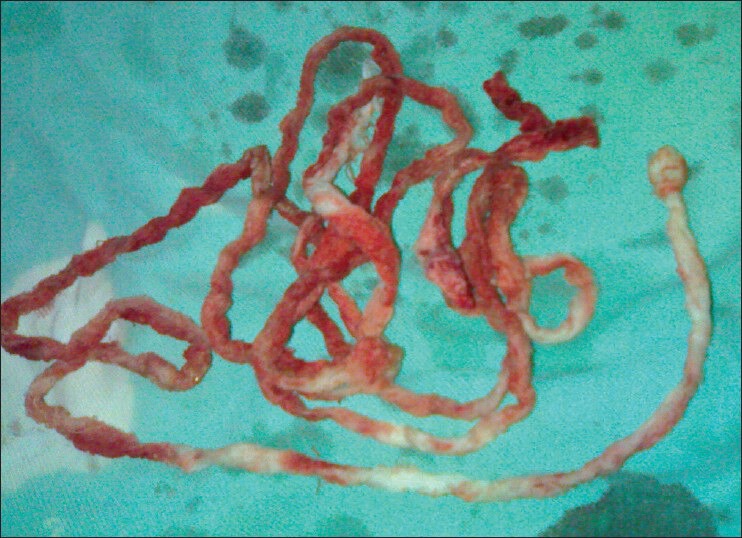Sir,
Functional endoscopic sinus surgery (FESS) is commonly carried out for various nasal sinus pathologies. The most feared complication significant for the anesthesiologist is the aspiration of blood into aerodigestive tract during the peri-op and post-op period. Various methods have been adopted from time to time to prevent aspiration of blood and secretions during the peri-op period including insertion of pharyngeal packs. Though various studies are at variance but ingestion of blood is strongly associated with a higher incidence of postoperative nausea and vomiting (PONV).[1] However, the effectiveness of pharyngeal packing in prevention of aspiration into aerodigestive tract has been questioned by few studies.[2]
There are no universal guidelines or protocols about the various aspects of pharyngeal packing including the material used, methodology of packing, and so on. As such, possibilities are always there that can account for seepage of blood into the aerodigestive tract. The aspiration of blood into trachea and digestive tract has its own set of complications and involve different management strategies. These therapeutic interventions to deal with resulting complications can add to the discomfort and cost of treatment.[3] The total hospital stay time also increases that further adds to the morbidity.[4]
The pharyngeal packs usually become soaked with blood and it is observed that blood can still seep through the pack into the aerodigestive tract. This phenomenon has been observed on numerous occasions whenever anesthesiologist or the ENT surgeon used to do the pharyngeal packing without the knot. The incidence of vomiting of ingested blood in three patients led us to design this technique. The technique of pharyngeal packing both by the anesthesiologist and the ENT surgeon was similar. We tried a unique way of pharyngeal packing for preventing the possible aspiration of blood into the aerodigestive tract. The anterior end of the roller gauze is given a double knot and this knotted end is placed just at the proximal junction of the aerodigestive tract. The double knot makes the anterior end of the roller gauze compact and symmetrical for the packing purpose that cannot be achieved with a single knot. Thereafter, rest of the pack is symmetrically placed around this knot covering the distal pharyngeal portion of the endotracheal tube (ETT) as well in a compact manner so as to make a tight seal without putting any pressure on the surrounding areas. Even the length of the pack is similar to the ordinary packing and it does not require any extra time to achieve compact packing as compared to normal method of packing. Postoperatively, when the pack is taken out, the distal portion of the pack hardly showed any soiling of the pack [Figure 1]. This intervention is being carried out routinely and the results obtained are similar in all the cases. The cuff portion of the ETT also shows minimal soiling after extubation.
Figure 1.

Dry portion of the knotted and distal end of the pharyngeal pack
Surprisingly we have not seen any incidence of postoperative nausea and vomiting in this subset of patients. No definite recommendations are in place for the usage of pharyngeal packs for prevention of PONV and aspiration of blood into trachea but the concerns of preventing such complications have not been addressed convincingly. Though, the results of few studies are not convincing about the usage of pharyngeal packing but damaging effect of such complications can never be underestimated.[2,5] It is a known fact that prevention is better than cure and use of pharyngeal packing definitely minimizes the aspiration of blood into the aerodigestive tract. This technique further helps in minimizing the incidence of any possible aspiration of blood during nasal surgeries. Using minor modifications this technique can be used for majority of oral surgeries as well as other nasal surgeries. However, we recommend a larger study assisted by statistical validation so as to see any definite benefit of such intervention and thereby preventing the complications associated with aspiration of blood into the aerodigestive tract.
REFERENCES
- 1.Sexton J, Dohlman L. Benefits of the pharyngeal pack. J Oral Maxillofac Surg. 1989;47:891. doi: 10.1016/s0278-2391(89)80056-4. [DOI] [PubMed] [Google Scholar]
- 2.Basha SI, McCoy E, Ullah R, Kinsella JB. The efficacy of pharyngeal packing during routine nasal surgery-a prospective randomised controlled study. Anaesthesia. 2006;61:1161–5. doi: 10.1111/j.1365-2044.2006.04868.x. [DOI] [PubMed] [Google Scholar]
- 3.Cohen MM, Duncan PG, De Boer DP. The postoperative interview: Assessing risk factors for nausea and vomiting. Anesth Analg. 1994;78:7–16. doi: 10.1213/00000539-199401000-00004. [DOI] [PubMed] [Google Scholar]
- 4.Chung F, Mezei G. Factors contributing to a prolonged stay after ambulatory surgery. Anesth Analg. 1999;89:1352–9. doi: 10.1097/00000539-199912000-00004. [DOI] [PubMed] [Google Scholar]
- 5.Korkut AY, Erkalp K, Erden V, Teker AM, Demirel A, Gedikli O, et al. Effect of pharyngeal packing during nasal surgery on postoperative nausea and vomiting. Otolaryngol. Head Neck Surg. 2010;143:831–6. doi: 10.1016/j.otohns.2010.08.030. [DOI] [PubMed] [Google Scholar]


